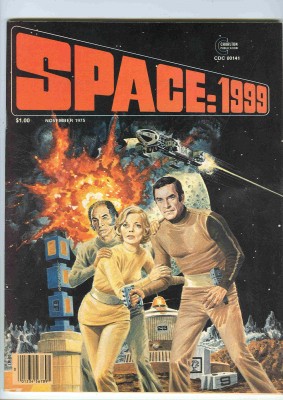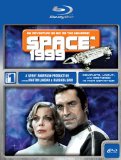| Reviews & Columns |
|
Reviews DVD TV on DVD Blu-ray 4K UHD International DVDs In Theaters Reviews by Studio Video Games Features Collector Series DVDs Easter Egg Database Interviews DVD Talk Radio Feature Articles Columns Anime Talk DVD Savant Horror DVDs The M.O.D. Squad Art House HD Talk Silent DVD
|
DVD Talk Forum |
|
|
| Resources |
|
DVD Price Search Customer Service #'s RCE Info Links |
|
Columns
|
|
|
Space: 1999: Season 1
In a way Space: 1999's strengths and weaknesses are the very opposite of the original Star Trek (1966-69), with which it is most often compared. Conceptually Star Trek, in its pilot stage and throughout its first season anyway, was intelligently, imaginatively, and exhaustively mapped out well in advance, while the execution of its ambitious ideas was much less successful. Produced by an aging television production company (Desilu) with no experience at all with big-scale, fantastic television, its production designs, special effects, etc., while conceptually interesting, were crudely executed. Space: 1999 had plenty of money and experience with this sort of show, but no one seemed to know what it was all about.
And yet people still watch. It has a relatively small but fiercely loyal fan following, understandable given its many fine qualities. A&E's new Blu-ray release of Season 1 only adds to the frustration - the show looks positively gorgeous. From a purely visual standpoint, the added clarity and improved color only make it seem more like an expensive feature film than a weekly television series. Moreover, several visual flaws, such as the opening titles, once plagued with grain and dirt due to optical printing, have been fixed; it's never looked better.
And yet I couldn't help nodding off during all but one of the shows I watched for this review. Who needs Diazepam when you've got Barbara Bain's whispery, somnambulistic performance to carry you off to Slumberland?
Nevertheless, the superlative transfers alone make Space: 1999 a worthwhile upgrade from A&E's earlier DVD releases. (And, it's worth noting, their Season 1 transfers were always significantly weaker than the much-improved Season 2 masters.) On top of that is an enormous feast of extra features. I was expecting mostly previously released material but in fact nearly all of the many supplements are new to U.S. home video.
Space: 1999 was the bastard child of the Andersons' previous show, the equally polished, equally dull UFO (1970-71). Initially, the ratings were unexpectedly good in America, and a second series was commissioned. But then the ratings plummeted in America and the series was cancelled. Gerry Anderson, not wanting to waste all the pre-production that had gone into that aborted second series, approached ITC Entertainment's Sir Lew Grade about refashioning these efforts into an entirely new series. In an attempt to draw American network television interest, ITC's American branch went after Martin Landau and Barbara Bain, the married former co-stars of Mission: Impossible, to headline the new show. Sylvia Anderson especially felt they weren't right for the series, but the Andersons ultimately went along with the plan, even after the Landaus (and/or their agent) made reportedly outlandish demands.
According to the Andersons, who themselves bitterly divorced at the end of Space: 1999's first season, the American offices of ITC also pushed them into other creative corners. Wanting a series set entirely in outer space, a la Star Trek, the Andersons came up with the show's outlandish premise: explosions from a nuclear waste dump break the moon free of its orbit around the Earth, hurling the satellite and its 300 or so human inhabitants out into deep space. They (and possibly the Landaus) also insisted upon American Lee H. Katzin to direct the pilot episode, "Breakaway," Katzin having helmed 11 Mission: Impossibles. To the Anderson's horror, Katzin ran the pilot 15 days over its 10-day shooting schedule, and his two-hour cut of the 50-minute episode had to be extensively re-shot. Other delays, such ITC's American office's insistence on script approval, resulted in a first series of 24 shows that took nearly 16 months to shoot, from November 1973 to the end of February 1975.
And yet, Space: 1999 seems to have moved very slowly in finalizing scripts and apparently never had the kind of "show Bible" common to American series. In one of the extra features co-star Barry Morse, who in frustration left the series at the end of season one, complained he never had any idea who his character was. Scripts weren't available until just before shooting and, reportedly, the Landaus would often take lines away from their supporting cast so they'd have more to do.
Though derivative of 2001 - the font used throughout the series, sets such as the nuclear waste dump in "Breakaway," the look of many effects shots (effects director Brian Johnson also worked on Kubrick's film) - the blandness of the dialogue and general dearth of expression and emotion, by design in Kubrick's film, here appear accidental or a symptom of the undercooked scripts. Some, like Morse, have no character to play, while others, like Bain, practically whisper their way through their parts, avoiding emotional reactions even when the circumstances call for one. For instance, after the moon is ripped from its orbit near the end of "Breakaway," no one at Moonbase Alpha seems too upset at the notion they may never see their loved ones back on earth ever again. Indeed, everyone adjusts unbelievably well. At the beginning of the second show, "Matter of Life and Death," they're already looking for a new planet on which to permanently migrate.
When characters do erupt with anger, the effect is almost always comic: frequently either Moonbase Alpha Commander John Koenig (Landau) will for no good reason start acting like Captain Queeg, totally irrational and hostile toward everyone else, or a supporting character (often chief pilot Alan Carter, played by Nick Tate) will inexplicably suddenly go off the deep end, with no purpose except to move the shaky plot forward and/or provide some artificially-induced dramatic conflict.
In another of the set's innumerable featurettes, mild-mannered Gerry Anderson (who seems interchangeable with character actor Philip Stone) says keeping the show grounded in plausible science simply wasn't a concern, citing the Concorde as an example of flight 19th century scientists would have considered impossible - therefore why worry about what's considered impossible today? Actual scientists were rarely consulted, just the opposite of producer Gene Roddenberry's approach to Star Trek. Instead, the show opts for a mystical, ambiguous, and at times almost non-narrative approach that simply doesn't work. The second year, supervised by Star Trek third-season producer Fred Frieberger, is more conventional and juvenile, but also agreeably lighter and overall a bit more entertaining. (The second-season opener, "The Metamorph," is included as an extra on Disc 5, and in high-def to boot! Many thanks to reader "wayneeklein" for pointing this out.)
Beyond the handsome production values and excellent special effects, the series boasted a similarly movie-like list of guest stars and directors, culled from the upper ranks of British cinema, then in financial freefall. Guest stars in season one include Roy Dotrice, Ian McShane, Margaret Leighton, Brian Blessed, Jeremy Kemp, Julian Glover, Douglas Wilmer, Joan Collins, Peter Bowles, Richard Johnson, Christopher Lee, Judy Geeson, Leo McKern, Peter Cushing, and Shane Rimmer (a longtime Anderson associate). Catherine Schell, later to join the Landaus as Space: 1999's second season co-star (as shape-shifting Maya), guest stars in a different role here. Directors chiefly included Charles Crichton, Bob Kellett, Ray Austin, and David Tomblin.
Video & Audio
As noted above, Space: 1999 looks positively spectacular in high-definition, a huge improvement over A&E's previous standard DVD release. Brian Johnson's special effects impressively hold up under high-definition scrutiny, and besides the added clarity of the filmed-in-35mm production, the colors - on standard DVD flat and dominated by whites, grays, and beiges - now pop with rich reds, violets, yellows, and blues. Moreover, the white backgrounds that were frequently dirty with grain and video noise are now solid and shaded, most notably in the beautifully redone opening titles, which have none of the ugly processed look they once had. The region "A" encoded set presents all 24 episodes uncut and in their original 1.37:1 format.
The 5.1 dts-HD Master Audio remix is also very impressive. I was frequently startled by the many directional sound effects and the extra oomph of the music tracks. Indeed, music-only audio is available on all but of the 24 episodes, which are presented across five discs. (Two more discs, standard-def DVDs, contain most of the extra features.) All this is contained in a case about double the size of a standard Blu-ray; menu screens are attractive and easy to navigate.
Extra Features
I expected most of the supplements to be identical to the 30th Anniversary Edition Megaset that I reviewed back in August 2007. Instead, I was surprised and delighted to find that the extensive extras, most originating on Britain's Network label, are new and utterly exhaustive.
Here's what's included: Gerry Anderson Audio Commentaries on "Breakaway" and "Dragon's Domain"; music-only tracks on everything except "Breakaway" and "Dragon's Domain"; HD Image Galleries (there is a veritable mountain of this material), with rare and previously-unseen photographs; HD galleries of related gum and cigarette cards; restored, textless titles; "These Episodes" featurettes, with over 90-minutes of individual episode analysis; a generic "Memories of Space" featurette; an on-camera Sylvia Anderson Interview, in which the producer-actress talks trash about the Landaus, Katzin, her husband, and just about everyone else for a good 16 minutes!; "Concept and Creation" & "Special Effects and Design" featurettes; text commentaries on "The Last Sunset" and "Space Brain"; "Clapperboard," a two-part special on Gerry Anderson from 1975, featuring clips from earlier Anderson shows; "Guardian of Piri Remembered," featuring Schell in an on-camera interview; Barry Gray's theme music demo; alternate titles; Martin Landau and Barbara Bain U.S. premiere intro and outro; SFX plates and deleted scenes; trailers and ad bumpers. Whew! Almost all of this material is interesting; fans of the series should be enthralled.
Parting Thoughts
Space: 1999 drives this reviewer crazy. It's a feast for the eyes - particularly now, in high-definition - yet it also inevitably puts me to sleep. Nevertheless, I can't help but want to work my way through it again, such is this set's appeal. For fans, this is Highly Recommended.
Stuart Galbraith IV's latest audio commentary, for AnimEigo's Musashi Miyamoto DVD boxed set, is on sale now.
|
| Popular Reviews |
| Sponsored Links |
|
|
| Sponsored Links |
|
|
| Release List | Reviews | Shop | Newsletter | Forum | DVD Giveaways | Blu-Ray | Advertise |
|
Copyright 2024 DVDTalk.com All Rights Reserved. Legal Info, Privacy Policy, Terms of Use,
Manage Preferences,
Your Privacy Choices | |||||||















